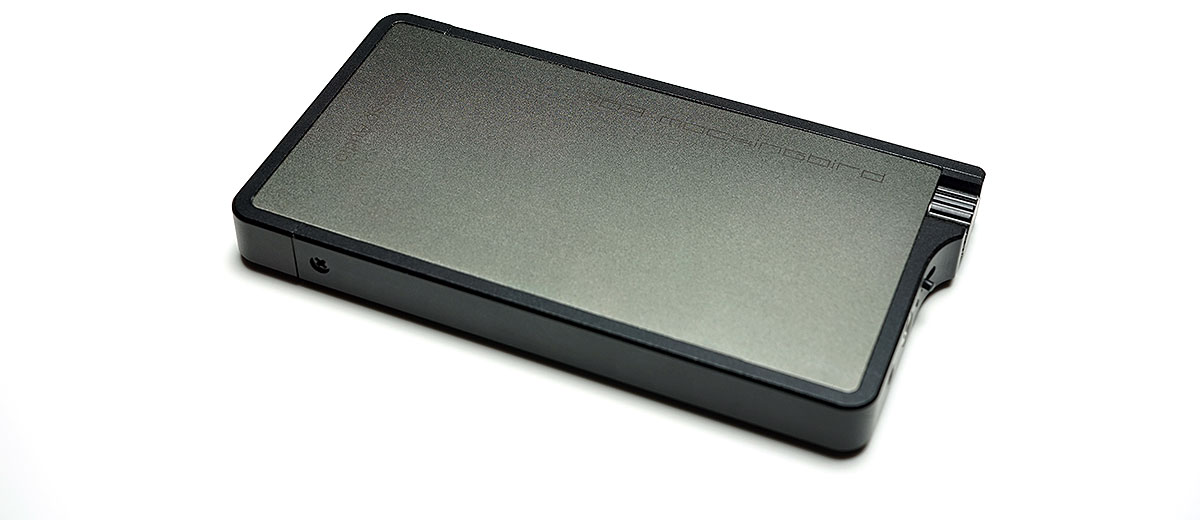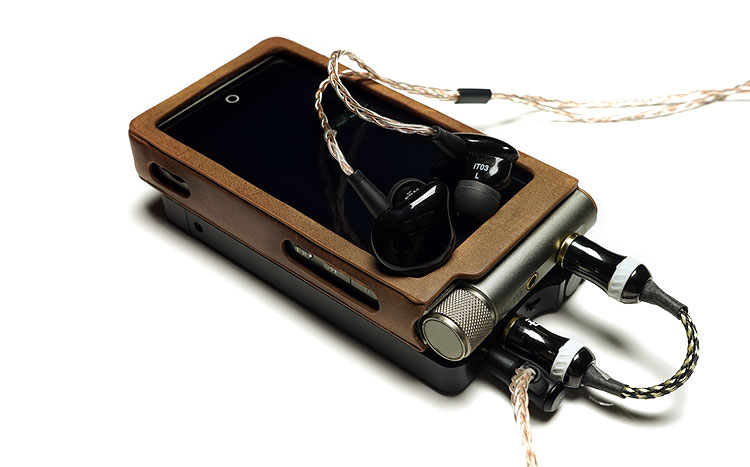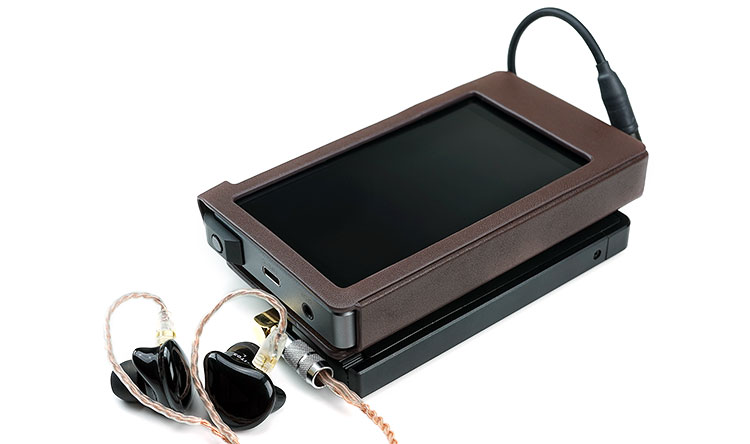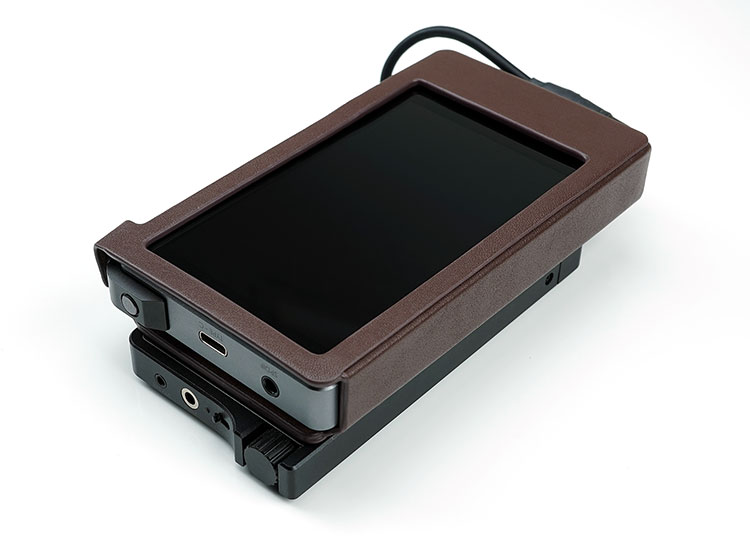Matchability
Sources
Sony PCM-D100
Noise-free very black background, dedicated line-out allowing a direct signal to the PB3 line-in. Very clean and balanced tonal quality, very little in the way of coloration. With highly sensitive IEMs you won’t get a huge amount of play with the PB3 pot using the D100’s quite powerful line-out but enough to operate it comfortably.
FiiO X5iii
Line out on the X5ii is fun sounding, noise-free but with a higher gain level meaning it’s a bit more aggressive than the DX200 on low-gain with less wiggle room on the pot much like the Sony D100.
Tonally this is a smooth laid back performance with a very nice level of resolution but not as detailed sounding as the DX100. In its favor, its low end has an excellent impact, with a forgiving and smooth top end and a rich mid-performance. It’s a step up on the X5ii built-in amp with better dynamics and lower noise.
This is a sweet combo for those disappointed with the noise levels and dynamics out of the X5iii internal amp but really enjoyed its musical approach.
iBasso DX200
DX200 Mango player utilizes variable line out control so you can fine-tune volume both on the PB3 and the DAP giving you tons of range in low gain and plenty of control for efficient IEMs and beyond. Noise levels are low, channel imbalance minimal and zero hiss with sensitive earphones and headphones using the PB3 pairing.
I do find the amp in the PB3 just to be that little bit warmer and smoother than the clean and flatter sounding reference amp module of the DX200. The top end also sounds marginally rolled off in comparison but with a very gentle low-end lift and fullness not found in the reference amp.
Sony ZX2
Black background, slight channel imbalance on efficient IEMs, steady gain setting on line-in output not as aggressive as the D100 or X5iii but not as low as the DX200. Pot control is reasonable and low gain is more than enough for the ZX2 pairing with IEMs. The Zx2’s own amp is comparatively noisier with efficient IEMs.
Tonally this is a more neutral presentation with a slightly harder sound than the DX200 and D100, not quite as natural sounding for me, slightly dark as expected but not as smooth. The Zx2 own amp is cooler sounding, slightly brighter with a leaner low end. The PB3 amp is just that bit smoother and richer sounding though doesn’t quite have the same sparkle in the treble which at times is not a bad thing.
IEMs
Soranik SK1
A single BA design from Vietnam known for a very smooth tonal presentation and excellent vocals. Paired with the PB3 with any source I got a low noise floor with no background hiss and decent headroom in low gain.
Tonally the SK1 and PB3 pairing works at its best with a neutral source and something that will not smooth out the top end response too much as the SK1 is not known for a forward treble response.
With the X5iii as a source, I felt the presentation via the PB3 lacked bite, dynamics, and sparkle. Both the SK1 and PB3 sounded cleaner, with better dynamics and superior resolution via the DX200 variable line out).
Campfire Andromeda
5 BA design with a wonderful treble extension and beefy low end but even more sensitive than the Shure SE846. If the Andromeda doesn’t hiss on your amp then your amp is good, very good.
With all DAPs tested as a source via the PB3 the Andromeda was noise free with a very good black background in low gain. This is an impressive pairing. If you can find hiss you really have to be looking for it such as if the filtering prowess of the PB3.
Tonally I really enjoyed the FiiO X5iii’s musicality with the PB3. The PB3 tightened up the bass a little and added some enhanced dynamics to the X5iii’s warm and laid back style. The only thing holding me back is just the lack of sparkle from either to really push the incredible treble performance of the Andromeda. For that, I found the PB3 paired with the DX200 or the Sony D100 to be a better match for resolution and extension.
iBasso IT03
You can’t do a PB3 review without reference to the IT03 hybrid IEM from iBasso themselves priced at around $250. On the PB3 this is a noise free experience with decent headroom and volume control in low gain. Your only concern is tonal matching.
Unbalanced
For those who want a smooth listening experience in unbalanced with slightly less focus on the lower treble peak of the IT03 then the PB3 is an excellent match. You get reasonable sparkle, a tight punchy low end and a smoother midrange than more neutral DAPs and amps. That mildly warmer top end of the PB3 and dynamic low end suits the IT03 perfectly.
The Dx200 will give you the cleanest signature with the PB3 with a bit more treble articulation and headroom on the PB3, the X5ii will pull it back a bit more and add some low-end weight sacrificing detail over musicality with the IT03.
Balanced
Running the IT03/PB3 in balanced mode (iBasso’s own balanced cable) tightens up the IT03 performance particularly the low-end snap, treble control, and vocal clarity. It still stays noise free also which is an excellent bonus.
RHA CL1
This is also a noise free pairing but the power demands are much higher. In unbalanced mode, you need to switch to high gain with a full volume line-out if variable or fixed line out to get the required power to drive the CL1 optimally. Even then you need a few turns of the PB3 Alps pot before you get a suitable listening level.
Tonally the pairing is just ok for me but the fact I can’t test the CL1 in balanced due to the odd shaped MMCX connectors puts this pairing at a disadvantage over say the IT03. In unbalanced mode, this pairing has got great detail, a nice warm full low end, slightly recessed vocals and a brittle lower treble but with plenty of headroom and extension.
It does a decent job with the treble edginess of the CL1, neither adding to it or overly smoothing it. Gentler genres with less percussion emphasis will do well with the CL1/PB3 pairing. I can listen to both but I think going balanced with the CL1 on the DACAMP L1 or pairing with a very resolving source DAC such as the AK380 will bring out the best in either.
Headphones
Hifiman Edition X
You can either go high in low gain or low to medium in high gain depending on your preferences with the Pb3. Mine was low to medium on high gain, I felt the presentation was a bit more dynamic and powerful sounding.
Now here is the interesting thing with the Edition X and PB3 pairing, what you feed the PB3 will make a fairly substantive difference in my opinion. Feed it the DX200 from iBasso and you get a rather beautifully detailed and relatively smooth presentation with a good balance right across the response curve.
Throw on the X5ii it gets much more musical with more low-end impact but less top end extension and not as resolving. I loved the tonality of the X5iii but the DX200 give me better detail. Pick from that what your preference might be.
HD600
No issues in driving the HD600 with medium volume setting on high gain with fixed line out on sources feeding the PB3.
The tonal presentation is decidedly neutral with the D100 and DX200 feeding the PB2 into the HD600 with a touch of warmth but lower resolution with the X5iii as the source. Nothing felt overly thin and I didn’t get a strong sense the PB3 was adding anything noticeable in terms of coloration.
AKG K872
Easy to drive, high volume low gain, or high gain medium to low volume your choice and black background to boot.
Best tonal pairing was the PB3/Sony PCM-D100 in this instance. Both the PB3 and D100 have a nice smooth tonal quality to their note with the D100’s rather flat delivery slightly, and I mean slightly, warmed up by the PB3 which suits the K872 perfectly. Treble is sparkling but never harsh, vocals clear and whilst the low end coherent and full but never overly dominant.
Select Comparisons
FiiO A5
$129
Truth be told the A5 is a very competitive offering from FiiO and if it not for the balanced output of the iBasso you could put up a really good reason for getting the A5. It is $70 cheaper for a start, packs in a pretty good MUSES02 OPAMP with bass boost options and excellent power ratings at 800mW into 30 ohms.
However, some numbers to think about with the PB3 which has a -120dB sensitivity rating compared to the A5 which comes in at -115dB offering as well as 20-hour battery life compared to the A5 at just 13 hours. Also, iBasso is a lot more confident with their THD numbers offering on paper <0.0005% THD compared to FiiO’s A5 THD+N paper rating at <0.002%.
Tonally, and in unbalanced mode the A5 offers warm to neutral and fairly smooth presentation but with a bit more low-end grunt and slam than the PB3 whereas the PB3 is slightly flatter but more open sounding with a sweeter midrange. Going balanced will tip the scale in favor of the PB3 with a tighter more dynamic presentation. If there is sibilance in the source tracks both will pick it up but the PB3 just smoothes it out marginally over the A5. The A5 has a touch more treble sparkle but not by much. If you want a bit more low-end weight get the A5, if you want a slightly warmer and smoother more balanced sound then the PB5 is the better option.
Cypher Labs Picollo
$399
The Picollo is twice as expensive and doesn’t output as much power (max 200mW vs 480mW) compared to the iBasso but it does have better gain and volume control on sensitive IEMs than the PB3 in low gain mode and battery life is around 20 to 30% longer than the iBasso. It also looks a bit more old school than the slimline PB3. Both have very good noise floors with no hiss for sensitive gear.
Tonally both have a warm to neutral signature with the PB3 offering slightly better dynamics. The Picollo sounds a bit softer and not as clean sounding in the mid to treble compared with the PB3 which comes across as more articulate and with a little more in terms of headroom.
Bass on the Picollo is fuller sounding than the PB3 but the PB3 has the superior snap and definition in its mid-bass performance hence the initial “soft” impressions. I actually think the Picollo extends better than the PB3 but it is more linear in its approach and not as impactful. Vocals on the PB3 are also a bit more forward sounding than the Picollo which tends to drop back a bit and do not stand out as much. Treble on the Picollo is also a bit easier going than the PB3’s more forward response and slightly better headroom.
ALO Audio RX
$349
The RX is a ‘cool old school’ in terms of design with its nickel alloy design that gives a nice retro feel compared to the sleeker, thinner modern design of the PB3. It an amp specifically for IEMs though strangely I found the PB3 to be the quieter of the two on the most sensitive of IEMs. Also, the pot gain is too aggressive on the likes of the Andromeda compared to the PB3 which is a little more gradual. Channel imbalance is also more noticeable on the RX as well as the fact the THD numbers are higher at <0.002% compared to the PB3 rating of <0.0005%.
Tonally though the RX is very dynamic sounding, with excellent extension, imaging, and a forward vocal presence. It’s a more neutral sound than the smoother and slightly more relaxed sounding PB3. Extension and headroom on the RX are excellent in both directions and it does show the PB3 to have just a tiny bit of roll off in the very last octave in comparison. Smooth is the watchword for the PB3, dynamic for the RX but note the RX is noisier for some IEMs.
Our Verdict
Whilst the PB3 inherits the avian titling series and is numbered one after the PB2 I actually think the PB3 is a slightly different bird than the previous PB series unit. Yes, it has balanced and unbalanced outputs but this time there is less of an emphasis on power and more on the tonal quality that this power is bringing to the table.
Gone also are the size and hirose connections, this is not pitched for headphone users (though they can use if they wish) but rather to IEM users who want the option of a balanced output to maximize the performance of their in-ear drivers.
It is not without coincidence that iBasso has specifically gone for an even harmonics bias to produce what I think is a smooth, resolving and excellent sound signature. Compared to competing amps it’s actually quite a balanced signature without an inherent low-end lift such as the A5 but it is warmer sounding than FiiO’s competitor amp which will suit those with neutral IEMs quite well.
I do miss the fact I can’t roll OPAMPs in the PB3 and also the fact I can no longer have a fully balanced setup, two big features that made the PB2 such fun. However, it is $100 less than the older amps so maybe this is a worthwhile compromise.
Technical Specifications
- Output power: ≤ 480mW
- Signal to noise ratio: ≥ 120dB
- Total harmonic distortion: <0.0005%
- Life time: 20H
- Earphone adapter impedance: 8 ~ 300Ω
- Size: 120 * 63 * 11.1mm
- Weight: 135g





